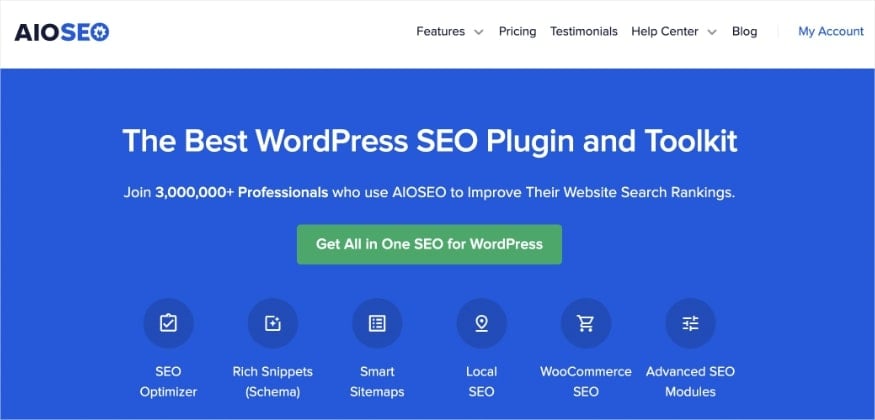Pagination SEO can feel like a tricky puzzle for WordPress sites with lots of content.
For ages, SEO experts have debated the best way to handle it. If you’re looking to finally understand and optimize your WordPress pagination for better search visibility, you’re in the right place. Having worked on many large sites, I’ve seen a pattern in pagination best practices.
In this guide, I’ll cut through the confusion and show you exactly how it’s done.
Feel free to use these quick links to jump straight to the different sections:
What Is Pagination?
Pagination refers to dividing content across multiple pages to improve usability and navigation. It’s especially useful for websites with large amounts of content, such as e-commerce sites, blogs, or forums. Instead of placing all the content on a single long page, it is split into smaller, more manageable chunks (pages). These are accompanied by numbered links or navigation controls, such as “Previous” and “Next.”
Here’s an example of how pagination can look:
Benefits of Pagination
Is pagination necessary?
Let me quickly highlight some of the most important SEO benefits of pagination.
Improved User Experience
Pagination helps users navigate content easily without overwhelming them with an excessively long page. This is particularly useful for product catalogs, blog archives, or discussion threads.
This improvement in user experience (UX) also has a bearing on your SEO as it leads to users spending more time on your site.
Internal Linking Opportunities
Pagination offers significant internal linking opportunities, which can benefit SEO and user navigation. This is because it inherently creates internal links between pages in a sequence using “Next,” “Previous,” and numbered links. Doing so helps pass link juice and improves crawling and indexing.
For eCommerce SEO, product category pages may feature links to related categories or popular items.
Faster Loading Times
Another important benefit of pagination is that it helps improve your page loading speeds. One reason for this is that it reduces the amount of data the browser needs to fetch, leading to faster initial page load times.
Page speed is a confirmed ranking factor, and this gives you an opportunity to optimize your content for better performance on search engines.
In short, not using pagination and keeping all your content on one page will make it difficult for users to navigate your site. It can also negatively impact UX and cause long load times, hurting your SEO and increasing the bounce rate.
With this in mind, let’s examine when to use pagination.
When Is Pagination Necessary?
Pagination is necessary when a site has several pages of content in a specific category or subcategory.
For example, your blog archive pages. Listing all of your blog posts on a single page wouldn’t give users a good experience.
Your visitors would have to scroll indefinitely, depending on the size of your blog. Accessing deeper content would be close to impossible.
Another example is an eCommerce website with a catalog comprising several hundred products, organized into different categories on a single page.
Just trying to scroll that page would tire you out…
…and it would be “mission impossible” trying to view all sneakers to know you’ve found the absolute best pair.
Anyway, now you understand why not using pagination can hurt the user experience. Let’s take a look at how pagination can impact your SEO.
How Can Pagination Affect SEO?
![Myth or Must-Have? [WordPress Edition] 1 SEO issues due to pagination infographic by Piktochart](https://aioseo.com/wp-content/uploads/2021/04/SEO-pagination-infographic-by-piktochart.png)
Pagination can impact SEO by limiting the crawl depth of your paginated pages, causing issues with duplicated content, and slowing down your site’s speed.
Let’s break this down a bit…
Understanding Crawl Depth
Crawl depth refers to how many clicks (or links) a search engine crawler must follow from the homepage or another key page to reach a particular page on your site. Pages deeper in the site’s structure are often crawled less frequently or may not be crawled at all, especially on large websites.
In essence, if you’ve got a huge number of archive pages with pagination, it may limit the depth at which search engines crawl your paginated content. This means your crawl budget (the number of pages Google will crawl on your site on any given day) for your important pages can become less.
Also, if pagination isn’t optimized, crawlers may struggle to find all pages in the series, especially if “Next” links don’t lead to every paginated page efficiently.
Duplicate Content Issues
Pagination can sometimes create duplicate content issues. FYI, duplicate content occurs when the same or very similar content appears on multiple URLs. This can confuse search engines and dilute the ranking potential of your pages. Here’s a detailed look at how pagination might lead to duplicate content and how to resolve it:
Repeated Content Across Paginated Pages
In cases where the same content appears across multiple paginated pages (e.g., product filters or category descriptions repeated on every page), search engines may view these pages as duplicates.
Thin or Similar Content
Paginated pages may display only minor differences, such as a small set of items (e.g., products or articles), while the rest of the page remains identical (headers, footers, navigation, etc.).
URL Parameters
Pagination is often implemented with URL parameters (e.g., example.com/blog?page=2), which can generate multiple URLs with similar content.
Infinite Scrolling and Canonicalization
If infinite scrolling is implemented poorly, it can create issues where paginated URLs coexist with a single long-scroll page, leading to duplicate content. Often, you have the same SEO title and meta description on your pages with pagination.
In such cases, duplicate content can cause difficulties for search engines in determining your most relevant pages for a specific search query.
To effectively handle this, you have to implement canonicalization. For instructions on how to do this, refer to our articles on canonical URLs and canonical tags.
Easily Optimize Your WordPress Pagination
Now that we’ve understood what pagination is and its implications, let’s quickly look at the best way to implement it on your site. In my opinion, the best way to optimize your pagination in WordPress is to use a powerful SEO tool like All In One SEO (AIOSEO).

AIOSEO is a powerful, easy-to-use SEO plugin with over 3 million active users. Because it’s regularly updated, you can rest assured the plugin stays abreast of changes in SEO best practices and keeps up with WordPress versions.
Millions of smart marketers and bloggers use AIOSEO to help them boost their search engine rankings and drive qualified traffic to their blogs because the plugin has many powerful features. These are designed to help you properly configure your SEO settings.
With AIOSEO, you don’t have to worry about pagination SEO. It helps ensure your SEO titles and descriptions are unique for your paginated content. It also allows you to customize them to maximize your SEO rankings.
This is how it works…
…when you have content that’s split across multiple pages, AlOSEO adds the word “Page” followed by the page number to the end of the SEO title and description.
That way, you don’t have to worry about confusing search engines with duplicate content.
For example, on our blog page, we show a Part 2 identifier in the SEO title for the 2nd blog archive page:
![Myth or Must-Have? [WordPress Edition] 2 Example of unique SEO title and description on AIOSEO's 2nd blog page](https://aioseo.com/wp-content/uploads/2021/04/seo-title-and-meta-description-paginated-content.png)
The page number is added automatically, but AIOSEO lets you customize the text before the pagination.
All you need to do is navigate to Search Appearance in the All in One SEO menu and click the Advanced tab.
![Myth or Must-Have? [WordPress Edition] 3 Search appearance and advanced settings in All in One SEO for implementing pagination SEO.](https://aioseo.com/wp-content/uploads/2021/04/search-appearance-menu-in-all-in-one-seo.png)
Next, scroll down to the Paged Format section. The pre-installed + Page Number tag will add the page number to your SEO title and description, making them unique.

And if you want to change the -Part text before the Page Number tag, you can just type in your own text directly into the field.
That’s it!
We hope this helped you understand pagination SEO and how to optimize your WordPress pagination. Use these tips, and you’ll boost rankings for your paginated content, as well as improve the user experience in a heartbeat.
Remember this: The easier it is for users to find your content, the easier it’ll be for Google as well!
In addition, one of the easiest ways to increase the accessibility of your important content and help Google find it is to make sure you’re using a good internal linking strategy.
Pagination SEO: Your FAQs Answered
What Is Pagination?
Pagination refers to dividing content across multiple pages to improve usability and navigation. It’s especially useful for websites with large amounts of content, such as e-commerce sites, blogs, or forums. Instead of placing all the content on a single long page, it is split into smaller, more manageable chunks (pages).
How does pagination impact link equity?
Pagination distributes link equity across multiple pages in a sequence. Pages further down in the sequence may receive less link equity, which can reduce their potential for ranking. Proper internal linking can help mitigate this.
What’s the best way to optimize pagination on my site?
The best way to optimize pagination on your site is to use a tool like AIOSEO. It takes the heavy lifting of manually paginating your pages and ensures they follow SEO best practices.
Pagination SEO: Definitely a Must-Have
Pagination significantly enhances user experience by breaking down lengthy content into manageable chunks, leading to faster page load times and improved site navigation. For SEO, it helps search engine crawlers efficiently index all your content, ensuring deeper pages aren’t missed. Strategically implemented pagination can also consolidate link equity across a series of pages, potentially boosting the ranking of the paginated content as a whole.
So, pagination SEO: myth or must-have?
Definitely a must-have!
We hope this article has helped you understand pagination SEO and how to implement it. You may also want to check out other articles on our blog, like our guide to common SEO mistakes to avoid or our tutorial on adding Google Search Console to your site.
If you found this article helpful, then please subscribe to our YouTube channel. You’ll find many more helpful tutorials there. You can also follow us on X (Twitter), LinkedIn, or Facebook to stay in the loop.
Disclosure: Our content is reader-supported. This means if you click on some of our links, then we may earn a commission. We only recommend products that we believe will add value to our readers.

![Myth or Must-Have? [WordPress Edition] 4 Image](https://aioseo.com/wp-content/uploads/2023/09/Image.png)
